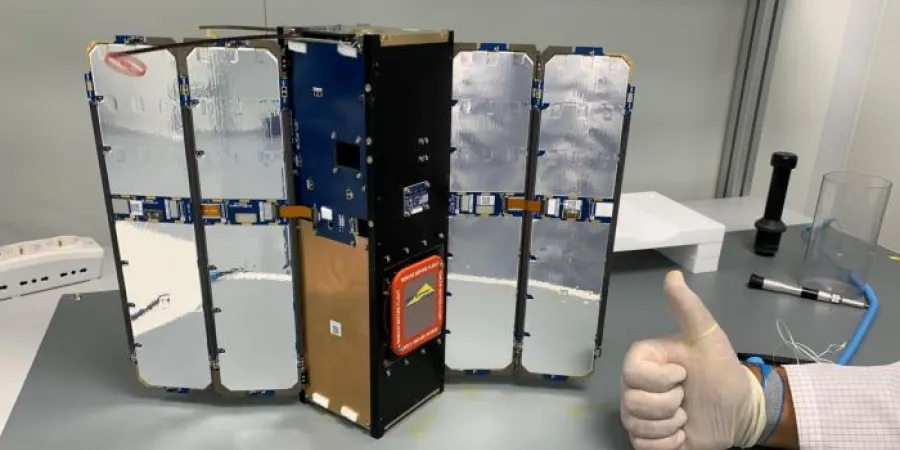Elbit Systems Launched a Nanosatellite for Communication Applications
The nanosatellite Nanova will provide, according to Elbit Systems, an effective solution for such applications as search and rescue, maritime fleet management & monitoring as well as M2M monitoring and sensing capabilities. Elbit Systems' nanosatellite, weighing just five kilograms, has been launched successfully from a space center in India
IsraelDefense
| 23/12/2019
Elbit Systems has announced today (Wednesday) that their nanosatellite Nanova was launched successfully into space. Nanova was developed jointly with a US company in the context of a project initiated by the BIRD Foundation, and is intended to be a part of a nanosatellite constellation providing civilian communication applications. The nanosatellite is operated from a ground control station established at an Elbit Systems facility in Haifa.
The Nanova nanosatellite was launched from Satish Dhawan Space Centre (SDSC) in southern India using the Indian Polar Satellite Launch Vehicle. After 18 minutes, at an altitude of 580 kilometers, the Nanova nanosatellite was released from the launch vehicle into its intended orbit.
The 3U size Nanova nanosatellite, weighing 5 kilograms, carries an Ultra-High Frequency (UHF) communication payload and provides a direct satellite communication link for conveying data, voice and text messages.
The Company stated: "Elbit Systems' many years of experience in the design, manufacturing and operational commissioning of space-borne cameras, structural space elements and satellite communication systems, along with its global leadership position in the fields of avionics, autonomous systems and artificial intelligence, constitute a unique technological infrastructure which enables the Company to provide end-to-end nanosatellite constellation solutions."
Yoram Shmuely, Executive VP and General Manager of Elbit Systems' Aerospace Division, said: "We are proud to commence our activities in the area of nanosatellite constellations. We plan to continue to invest in this emerging field, expanding our sensing capabilities and the range of potential applications."
"The combination of Elbit Systems' mature technologies and capabilities with off-the-shelf components ruggedized for space operations, a state-of-the-art user interface and sophisticated analytics tools enable the Nanova nanosatellite to provide a reliable and economically-attractive communication service solution for areas with limited or no satellite coverage. Communication services of this type are currently required for a number of commercial applications such as search and rescue, emergency communication in remote areas, logistic management and monitoring of maritime fleets and machine-to-machine monitoring and sensing capabilities for various needs," Elbit Systems announced.
The nanosatellite Nanova will provide, according to Elbit Systems, an effective solution for such applications as search and rescue, maritime fleet management & monitoring as well as M2M monitoring and sensing capabilities. Elbit Systems' nanosatellite, weighing just five kilograms, has been launched successfully from a space center in India
Elbit Systems has announced today (Wednesday) that their nanosatellite Nanova was launched successfully into space. Nanova was developed jointly with a US company in the context of a project initiated by the BIRD Foundation, and is intended to be a part of a nanosatellite constellation providing civilian communication applications. The nanosatellite is operated from a ground control station established at an Elbit Systems facility in Haifa.
The Nanova nanosatellite was launched from Satish Dhawan Space Centre (SDSC) in southern India using the Indian Polar Satellite Launch Vehicle. After 18 minutes, at an altitude of 580 kilometers, the Nanova nanosatellite was released from the launch vehicle into its intended orbit.
The 3U size Nanova nanosatellite, weighing 5 kilograms, carries an Ultra-High Frequency (UHF) communication payload and provides a direct satellite communication link for conveying data, voice and text messages.
The Company stated: "Elbit Systems' many years of experience in the design, manufacturing and operational commissioning of space-borne cameras, structural space elements and satellite communication systems, along with its global leadership position in the fields of avionics, autonomous systems and artificial intelligence, constitute a unique technological infrastructure which enables the Company to provide end-to-end nanosatellite constellation solutions."
Yoram Shmuely, Executive VP and General Manager of Elbit Systems' Aerospace Division, said: "We are proud to commence our activities in the area of nanosatellite constellations. We plan to continue to invest in this emerging field, expanding our sensing capabilities and the range of potential applications."
"The combination of Elbit Systems' mature technologies and capabilities with off-the-shelf components ruggedized for space operations, a state-of-the-art user interface and sophisticated analytics tools enable the Nanova nanosatellite to provide a reliable and economically-attractive communication service solution for areas with limited or no satellite coverage. Communication services of this type are currently required for a number of commercial applications such as search and rescue, emergency communication in remote areas, logistic management and monitoring of maritime fleets and machine-to-machine monitoring and sensing capabilities for various needs," Elbit Systems announced.



